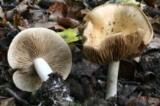
Hebeloma
Encyclopedia
Hebeloma is a genus
of fungi. Found worldwide, it contains the poison pie or fairy cakes (Hebeloma crustuliniforme
) and the ghoul fungus (H. aminophilum
), from Western Australia
, which grows on rotting animal remains.
word of Hebe, "youth," or "puberty," and the suffix -loma, a fringe (pertaining to the fungal veil
). Thus, Hebeloma translates as "youthful fringe/veil," in reference to how the fungal veil is only seen in immature specimens.
Genus
In biology, a genus is a low-level taxonomic rank used in the biological classification of living and fossil organisms, which is an example of definition by genus and differentia...
of fungi. Found worldwide, it contains the poison pie or fairy cakes (Hebeloma crustuliniforme
Hebeloma crustuliniforme
Hebeloma crustuliniforme, commonly known as poison pie or fairy cakes, is a gilled mushroom of the genus Hebeloma found in Europe and North America, and has been introduced into Australia. Its specific name derives from the Latin crustulum or little biscuit...
) and the ghoul fungus (H. aminophilum
Hebeloma aminophilum
|Hebeloma aminophilum, commonly known as the ghoul fungus, is a species of mushroom in the Hymenogastraceae family. Found in Western Australia, it gets its common name from the propensity of the fruiting bodies to spring out of decomposing animal remains. Its edibility is unknown.-Taxonomy:The...
), from Western Australia
Western Australia
Western Australia is a state of Australia, occupying the entire western third of the Australian continent. It is bounded by the Indian Ocean to the north and west, the Great Australian Bight and Indian Ocean to the south, the Northern Territory to the north-east and South Australia to the south-east...
, which grows on rotting animal remains.
Etymology
The generic name is a compound Ancient GreekAncient Greek
Ancient Greek is the stage of the Greek language in the periods spanning the times c. 9th–6th centuries BC, , c. 5th–4th centuries BC , and the c. 3rd century BC – 6th century AD of ancient Greece and the ancient world; being predated in the 2nd millennium BC by Mycenaean Greek...
word of Hebe, "youth," or "puberty," and the suffix -loma, a fringe (pertaining to the fungal veil
Veil (botany)
A veil, in mycology, is one of several structures in fungi, especially the thin membrane that covers the cap and stalk of an immature mushroom.Veils may be regarded as falling into two categories:*Partial veil*Universal veil...
). Thus, Hebeloma translates as "youthful fringe/veil," in reference to how the fungal veil is only seen in immature specimens.
External links
- The veiled species of Hebeloma in the western United States by Alexander H. SmithAlexander H. SmithAlexander Hanchett Smith was an American mycologist known for his extensive contributions to the taxonomy and phylogeny of the higher fungi, especially the agarics.-Early life:...
, Vera Stucky Evenson, and Duane H. Mitchel, 1983. (Full text of monograph.)

